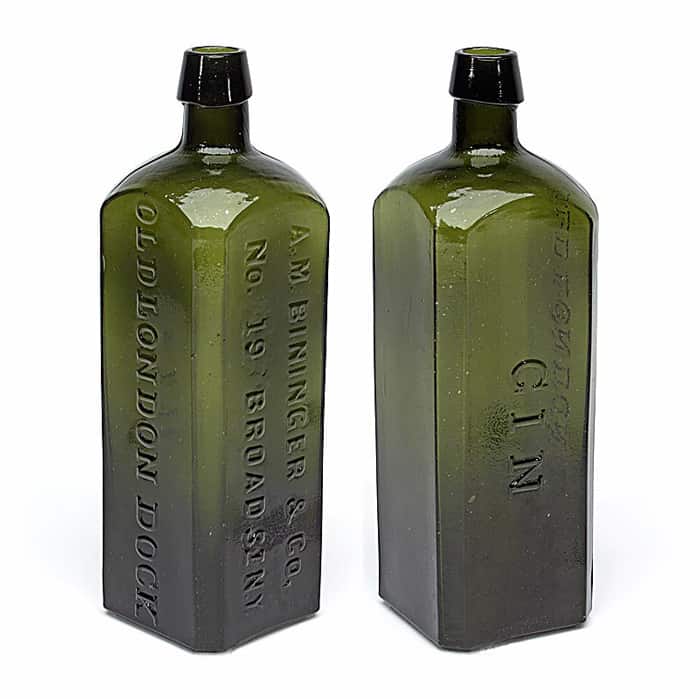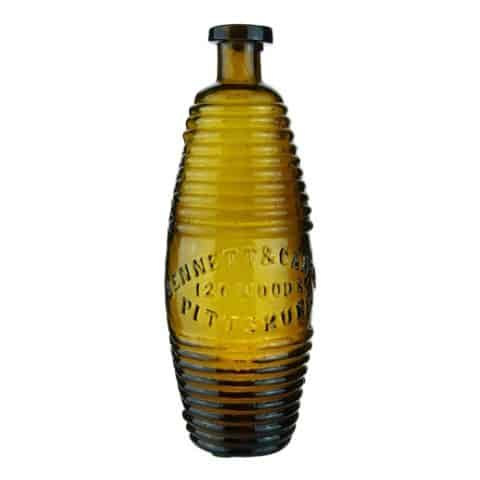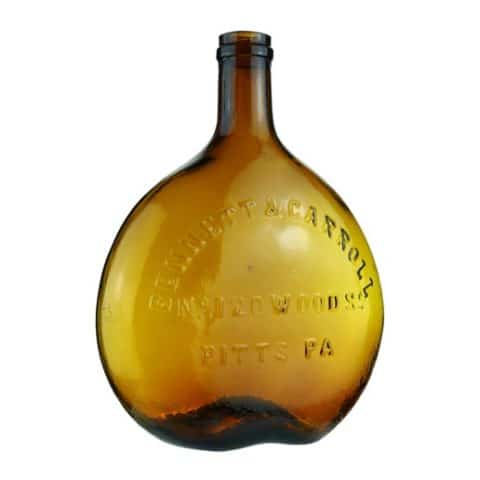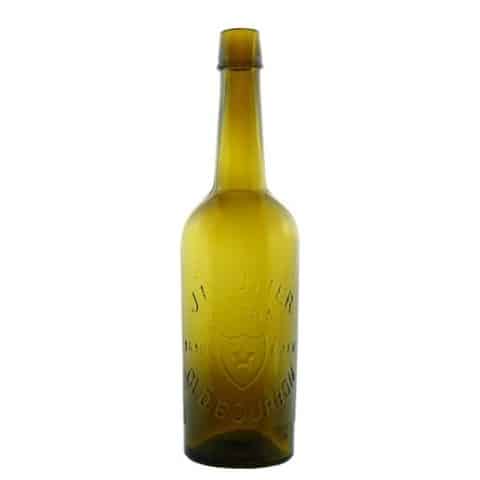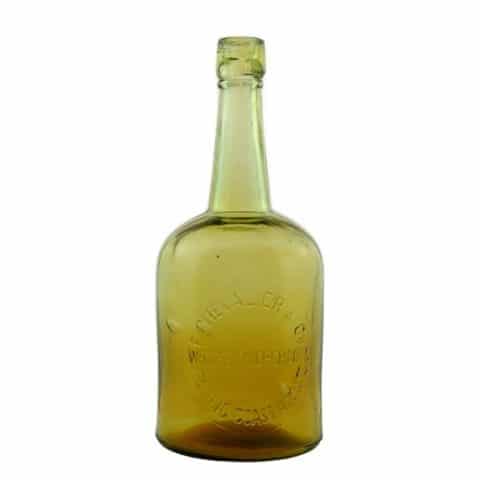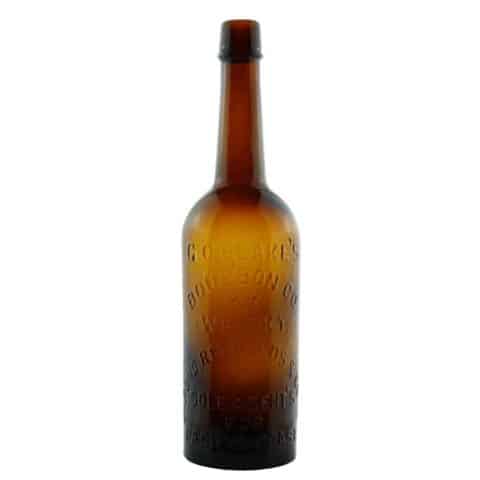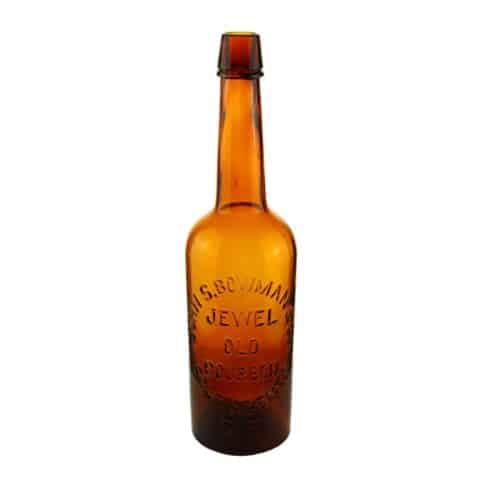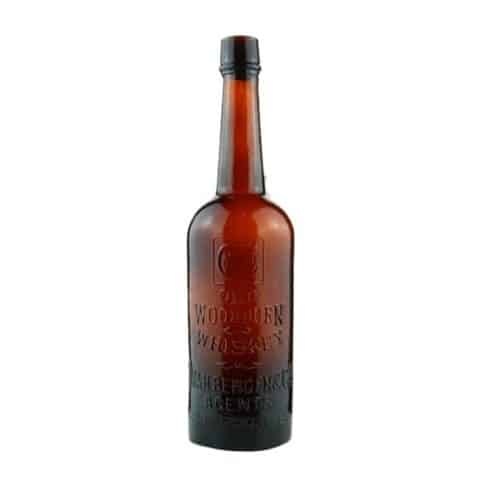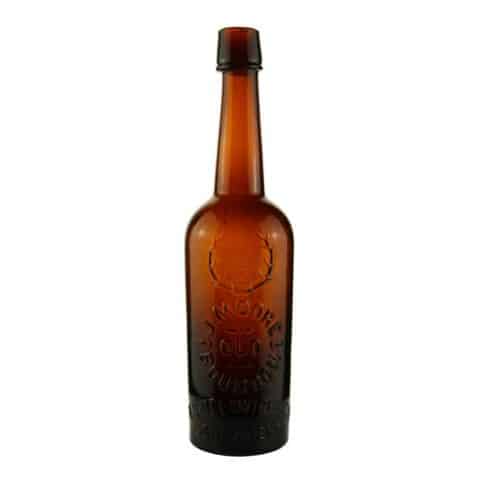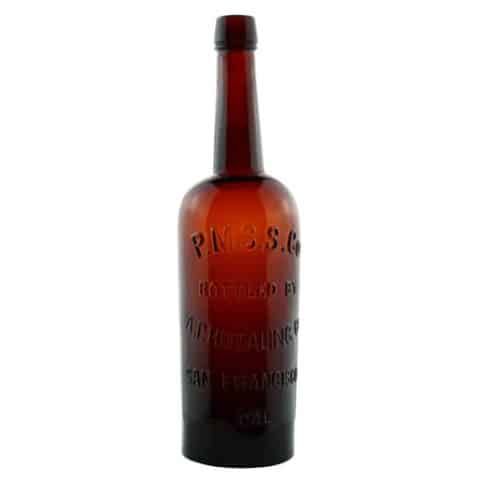A.M. Bininger & Co. No. 19 Broad St N.Y. Old London Dock Gin
Old London Dock Gin
A. M. Bininger & Co.
No. 19 Broad St. N.Y.
A. M. Bininger & Co., New York City, New York
Olive Green Square
Provenance: Chris Bubash Collection

Antique bottle collectors cherish Bininger bottles from New York City. The variety of shapes, embossing, glass color, labels, and history is remarkable. Abraham Bininger would establish the famed A. Bininger grocery house. His brother Isaac and son Abram Merritt Bininger were responsible for the parallel Bininger liquor empire and A. M. Bininger & Co., located at various addresses in New York City. Bininger’s Old London Dock Gin bottles are interesting as they can be found with three different addresses embossed on the bottle.
Our primary museum example is embossed “Old London Dock Gin A. M. Bininger & Co. No. 19 Broad St. N. Y.” Late 1850s advertising said that Bininger’s Old London Dock Gin should be used as a “Remedial Agent. This delicious Tonic Stimulant, especially designed for the use of the Medical Profession and the Family, having superseded the so called “Gins,” “Aromatic,” “Cordial,” “Medicated,” “Schnapps,” etc., is now indorsed (sic) by all the prominent Physicians, Chemists and Connoisseurs as possessing all of those Intrinsic medical qualities (tonic and diuretic) which belong to the Old and Pure Gin. Put up in quart bottles and sold by all Druggists, Grocers, etc. A. M. Bininger & Co., Sole Proprietors, No. 19, Broad Street, New York.”

Our primary museum example of an Old London Dock Gin square has distinct beveled panels and base sides and was made in olive-green glass. There is an applied sloping collared mouth and a smooth base. The height is 9 ½ inches. The embossed copy occurs on three of four panels from shoulder to base. The first panel reads, ‘OLD LONDON DOCK’ in a single line in a classical serif typestyle. The second panel has ‘GIN’ in large open-spaced letters. The third panel with the proprietor information is embossed in a sans-serif typestyle ‘A. M. BININGER & CO. NO. 19 BROAD ST. N.Y. in two lines. The “T” in “St.” is smaller, raised, and underscored. The fourth smooth side is where the paper label was placed (see museum example).


Our secondary museum example (see spinner) of an embossed Old London Dock Gin square is very similar to the primary example but is a medium grass green color. The proprietor panel is different as it is embossed “No. 338 Broadway.” Yet another address variant is available with a “No. 17 Broad St. N.Y.” Advertising also listed them at “No. 16 Broad Street,” “119 Broad Street” and “15 Beaver Street” between 1858 and 1868 or so.

Though these bottles were made in the late 1850s you will not find pontiled examples. You can find examples of this bottle in amber, yellowish amber, orangish amber, honey amber, golden amber, yellow olive amber, grass green, yellow-green, yellow olive green, olive green, and deep olive gree glass shades.

The Bininger Empire
The eldest or founder of the American Bininger name was Abraham Bininger, born in 1720 (d 1811) and a native of Bulock (or Baden-Bulach) in Canton Zurich, Switzerland. In 1734, he came with his father, Christian Bininger, and mother on a brig from a European port to Savannah, Georgia.
The vessel was within two days’ sail of her port when Christian Bininger and his wife died, and their bodies were committed to the deep. Young Abraham, then a lad, was educated in the great Methodist Whitfield Orphan School in Savannah. A large crowd of Moravians had settled in this Southern city. This group emigrated north to Philadelphia, and young Bininger came with them, where he was educated in the Moravian tenets with the intention of becoming a preacher in that faith.
Abraham settled at Christian Spring, a mile from Nazareth, and there began his preaching. He married during this time and became the father of five sons and a daughter who died very young. The second eldest was named Abraham, who was destined to found the great Bininger grocery house in 1778 in New York City. His brothers were Christian, Joseph, John, and Isaac. The 1778 date is prominently displayed on many Bininger advertisements.
In 1761, Abraham was dispatched to New York to begin an apprenticeship at a tanner and leather dresser trade in the Swamp. Back in the early days of New York, Manhattan was narrower, swampy, and full of slips which were narrow slivers of harbor left for boats. Abraham served there for seven years but did not like the business and declared he would never engage in it for a living.
After his apprenticeship, Abraham made a living by working a day’s work as a common laborer. He hired out wherever he could get a job. He had at this time a friend named Peter Embury, who was a nephew of the Methodist minister, the founder of John Street Church. Peter was also a celebrated and well-known grocer and wine merchant. Embury went into the grocery line early and was located at the corner of Beekman and Nassau streets. Peter had a sister, and she married Abraham Bininger when he left the tanning business.
Kate Embury Bininger was a beautiful, outgoing girl and was very smart. She soon discovered that it was uphill work for her husband Abraham to support a family with the earnings of a day laborer, and she proposed to assist him by taking in washing and ironing. Abraham agreed, and their little money-making endeavor commenced. Kate then suggested that Abraham purchase a sales table to stand outside their door, and she would, while washing, keep her eyes looking out of the window at this table and the contents of their merchandise.
Their place of business was a little shanty on old Augustus street, eventually City Hall Place. At first, the young wife only sold a few cakes, cookies, and sugar plums. It changed to cabbages, potatoes, fruits, tobacco, snuff, and a few groceries. Here was indeed the first seed of the great Bininger grocery house.
As noted previously, Isaac Bininger was the brother of Abraham and, after the war, lived with his father at Camden Valley, N.Y. He was rather educated compared to his brother Abraham. Isaac opened a store at Camden Valley, described as the most extensive store between Albany and Montreal, even though this was a rather primitive region and time. Isaac was the genesis of the A. M. Bininger liquor empire.
Isaac was very successful and sent word down to New York City for his brother Abraham to come up and share in the mercantile prosperity of the Bininger stock. Abraham departed New York, leaving his wife Katy in charge of the shop on Augustus street, and joined his brother at Camden Valley as a partner. After a short time, the brothers decided that Abraham should return to New York, sell or barter away the produce and products from his and Kate’s stand, and buy goods for a return trip. Abraham, following the agreement, returned to New York, never to leave it again as all this experience allowed him to start the great grocery house under his name. Up to this period, Abraham and Kate’s business had not progressed beyond selling a few penny’s worth of snuff, sugar, tobacco, candies, and vegetables. After working with his brother Isaac for some time now and being the sole agent for New York City, they dissolved the partnership, and Abraham received his share of the profits.
Abraham would open a small grocery store in Maiden Lane, opposite the old Oswego market. It was a great store in those days as it became the place to buy fresh produce, fruits, and groceries. Prosperity flowed in, and the prudent grocer bought two lots opposite the market, Nos. 10 and 12 Maiden Lane. By 1843, it was said that no house in the United States had such a large stock of grocery items, choice wines, liquors, cigars, and such.
Abram Merritt Bininger, Isaac’s son, was born in 1800 and would follow a similar path, starting in groceries. He founded A. M. Bininger, eventually becoming A. M. Bininger and Co., located at No. 19 Broad Street. This address is embossed on the primary museum bottle. This company was responsible for all the great bottles, advertising, and labels.
Interestingly, both entities said they were the “first” retail Bininger, which is another story. A. M. Bininger would die in October 1870. His obituary said he was one of the oldest merchants of New York City and was a gentleman highly respected and esteemed by all who knew him.
See the museum example of a Bininger’s Peep-O’-Day flask.
See the museum example A.M. Binninger & Co. No. 19 Broad St. New York A. M. Bininger & Co. handled cylinder.
See the museum example of Bininger’s General Scotts Artillery Bitters.
Primary Image: Old London Dock Gin A. M. Bininger & Co. No 19 Broad St. N.Y. olive green square imaged on location by Alan DeMaison, FOHBC Virtual Museum Midwest Studio.
Secondary Image: Old London Dock Gin A. M. Bininger & Co. No 338 Broadway grass green square imaged on location by Alan DeMaison, FOHBC Virtual Museum Midwest Studio.
Support Image: Auction Lot 161: “Old London Dock / Gin / (Crown) / A.M. Bininger & Co, / No, 17 Broad St” Gin Bottle, America, 1860-1880. Square with beveled corners, medium yellow green, applied sloping collared mouth – smooth base, ht. 9 3/4 inches. BB #BPK-8C A beautiful example with numerous bubbles, bold embossing and the scarce embossed “Crown” on the shoulder. Fine condition. – Norman Heckler Jr. & Sr., Norman C. Heckler & Company, Auction #185
Support Image: Auction Lot 30: “Old London Dock / Gin / A. M. Bininger & Co. / No. 19 Broad St N. Y.” Gin Bottle, America, 1860-1870. Square with beveled corners, medium yellowish green, applied sloping collared mouth – smooth base, ht. 9 1/2 inches. Similar to H #2010 Brilliant glass with numerous bubbles and overall clarity. Fine condition. – Norman Heckler Jr. & Sr., Norman C. Heckler & Company, Auction #135
Support Image: Auction Lot 97: “A.M. Bininger & Co, / No. 338 Broadway. / Old London Dock / Gin” Bottle, America, 1860-1870. Square with beveled corners, yellow with an olive tone, applied sloping collared mouth – smooth base, ht. 9 1/2 inches; (large bubble on Bininger side at the shoulder has some interior residue). Great color. Big, beautiful bottle. – Norman Heckler Jr. & Sr., Norman C. Heckler & Company, Auction #101
Support Image: Auction Lot 13: “A.M. BININGER & CO. / NO. 17 BROAD ST. – OLD LONDON DOCK – GIN”, (Denzin, BIN-15), New York, ca. 1855 – 1870, yellowish olive green, 9 7/8”h, smooth base, applied mouth, 98% original label reads: ‘Old London Dock Gin, Designed Especially as a Safe & Reliable Medicine For Family Use, A.M. Bininger & Co. Importers No. 17 Broad St., New York’. A tiny flake is off the a corner edge at the base, otherwise perfect. A scarce bottle with the early No. 17 Broad St. address. – Jim Hagenbuch, Glass Works Auctions, February 2013
Support Image: Bininger’s Olds London Dock Gin color lithography advertisement, Heppenheimer, Frederick, printer. Circa 1859, Jay T. Last Collection of Graphic Arts and Social History, The Huntington, Library, Art Museum, and Botanical Gardens
Support: Reference to The Old Merchants of New York City by Joseph Alfred Scoville, 1863
Support: Reference to Abraham Bininger by John B. Pine, The New York Genealogical and Biographical Record. Devoted to the Interests of American Genealogy and Biography (1870-1910); New York Vol. 33, Iss. 3, (Jul 1902): 135.
Support: Reference to A. M. Bininger Bottles by Jim Bender, Sprakers, New York, 2017
Support: Reference to Bininger Advertising Art & Labels at PeachridgeGlass.com. Ferdinand Meyer V, August 2012.
Join the FOHBC: The Virtual Museum is a project of the Federation of Historical Bottle Collectors (FOHBC). To become a member.



